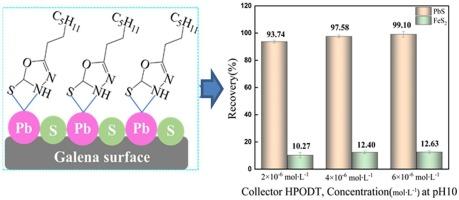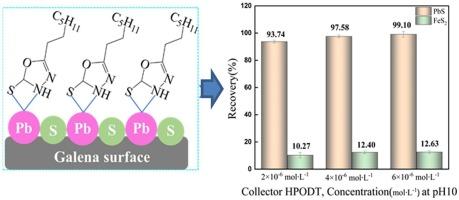中碱性条件下5-庚基-1,3,4-恶二唑-2-硫酮选择性浮选黄铁矿中的方铅矿
IF 6.9
2区 材料科学
Q2 CHEMISTRY, PHYSICAL
引用次数: 0
摘要
传统黄原药捕收剂对方铅矿的浮选分离需要石灰维持高碱性介质,生产过程中产生二氧化碳。研究了新型捕收剂5-庚基-1,3,4-恶二唑-2-硫酮(HPODT)在中碱性矿浆中不添加石灰的情况下浮选分离方铅矿和黄铁矿。微浮选结果表明,在pH ~ 10.0、6 × 10−6 mol·L−1的条件下,HPODT和辛基黄药钠(OXS)的浮选回收率分别为99.3% %和83.8% %方铅矿,以及5.3% %和75.6% %黄铁矿,说明HPODT对方铅矿与黄铁矿浮选分离的选择性明显优于OXS。紫外光谱显示,在pH ~ 10.0条件下,HPODT在方铅矿上的吸附量远大于在黄铁矿上的吸附量,这支持了它们的浮选和接触角结果。原位AFM结果表明,HPODT在方铅矿表面形成自组装聚集体。XPS证实,HPODT的恶二唑-硫酮基团的外s和内n原子与方铅矿上的Pb原子结合,传递Pb(II)-HPODT配合物。作为一个大共轭构型,恶二唑-硫酮基团通过电子离域效应具有较弱的给电子能力和较强的电子接受能力,提高了HPODT对方铅矿上Pb(II)和黄铁矿上Fe(III)/Fe(II)的选择性亲和力。本文章由计算机程序翻译,如有差异,请以英文原文为准。


Selective flotation of galena from pyrite utilizing 5-heptyl-1,3,4-oxadiazole-2-thione under medium alkaline conditions
The flotation separation of galena from its ores with traditional xanthate collectors needs the high alkaline media maintained by lime which production releases CO2. In this study, a novel collector, 5-heptyl-1,3,4-oxadiazole-2-thione (HPODT), was investigated in flotation separation of galena from pyrite under a moderate alkaline pulp without addition of lime. The micro-flotation results demonstrated that at pH ∼10.0, 6 × 10−6 mol·L−1 HPODT and octyl xanthate sodium (OXS) floated out 99.3 % and 83.8 % galena, as well as 5.3 % and 75.6 % pyrite from their mixture, respectively, deducing the much better selectivity of HPODT for flotation separation of galena against pyrite than OXS. UV spectra exhibited that under pH ∼10.0, the adsorption amount of HPODT on galena was much bigger than that on pyrite, which supported their flotation and contact angle results. In situ AFM gave out clear evidences that HPODT formed self-assembled aggregates on galena surface. XPS confirmed that the exo-S and endo-N atoms of HPODT’s oxadiazole-thione group bonded with the Pb atom(s) on galena to deliver the Pb(II)-HPODT complexes. As a big conjugated configuration, the oxadiazole-thione group possessed the weak electron-donating and strong electron-accepting ability through electron delocalization effect, which improved the selective affinity of HPODT towards Pb(II) on galena against Fe(III)/Fe(II) on pyrite.
求助全文
通过发布文献求助,成功后即可免费获取论文全文。
去求助
来源期刊

Applied Surface Science
工程技术-材料科学:膜
CiteScore
12.50
自引率
7.50%
发文量
3393
审稿时长
67 days
期刊介绍:
Applied Surface Science covers topics contributing to a better understanding of surfaces, interfaces, nanostructures and their applications. The journal is concerned with scientific research on the atomic and molecular level of material properties determined with specific surface analytical techniques and/or computational methods, as well as the processing of such structures.
 求助内容:
求助内容: 应助结果提醒方式:
应助结果提醒方式:


